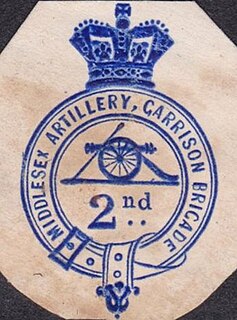
The Liverpool Rifles was a unit of the Territorial Army, part of the British Army, formed in Lancashire as a 'Rifle Volunteer Corps' (RVC) in 1859, becoming a battalion of the King's Regiment (Liverpool) in 1881. It saw action on the Western Front in World War I and later became a searchlight unit of the Royal Artillery in World War II.

The Norfolk Yeomanry was a volunteer cavalry (Yeomanry) regiment of Britain's Territorial Army accepted onto the establishment of the British Army in 1794. After seeing action in the Second Boer War, it served dismounted at Gallipoli, in Palestine and on the Western Front during the First World War. Between the wars it converted to the Royal Artillery (TA), and served as an anti-tank regiment in France, the Western Desert, Italy and North West Europe during the Second World War. After the war it served as a TA air defence unit and then as an Army Air Corps unit.

The 1st London Field Company, Royal Engineers was a Territorial engineer unit of the British Army active during World War I. Formed in 1908, it was based in Bethnal Green in East London.
The 57th Division was an infantry formation of the Territorial Force created in 1914 as part of the massive expansion of the British Army during the First World War. It served on the Western Front during 1917 and 1918. The divisional number was reactivated for deception purposes during the Second World War.

The Hampshire Yeomanry was a yeomanry cavalry regiment formed by amalgamating older units raised between 1794 and 1803 during the French Revolutionary Wars. It served in a mounted role in the Second Boer War and World War I, and in the air defence role during and after World War II. The lineage is continued by 295 Battery and 457 Battery, batteries of 106 (Yeomanry) Regiment Royal Artillery, part of the Army Reserve.

75th Division was an infantry division of the British Army in World War I. It was raised in the field by the Egyptian Expeditionary Force (EEF) in 1917 and it included British, Indian and South African troops. It served in the Middle East during the Sinai and Palestine Campaign being involved in the Battles of Megiddo.
The 206th Brigade was a formation of the British Army during World War I. It was raised as a 2nd-Line duplicate of the Essex Brigade of the Territorial Force and formed part of the 69th Division. It served as a training formation in the United Kingdom without going overseas.

The 219th Brigade was a Home Service formation of the British Army during World War I and World War II.
The 222nd Infantry Brigade was a Home Service formation of the British Army that existed under various short-lived titles in both the First and Second World Wars
221st Mixed Brigade was a Scottish Home Service formation of the British Army that served under various titles throughout World War I.

The 223rd Brigade was a Home Defence formation of the British Army in World War I and World War II. It existed under several variations of the 223 Brigade title, and was eventually converted into an airborne formation.
71st Division was a short-lived infantry division of the British Army during the First World War. It served in the Home Defence forces and never went overseas.

The 17th Battalion, The London Regiment , was a unit of Britain's Territorial Force formed in 1908 from Volunteer corps dating back to 1859. It saw considerable service on the Western Front, at Salonika and in Palestine during World War I. It served as an infantry regiment during World War II before conversion to an artillery unit in 1947 and subsequent amalgamation in 1967.
The IV East Anglian Brigade of the Royal Field Artillery was a unit of Britain's Territorial Force (TF) from 1908 to 1919. It served in the Sinai and Palestine Campaign during World War I.

The 2nd Middlesex Artillery was a Volunteer unit of Britain's Royal Artillery. First raised in the Victorian era among Customs officers in the Port of London, it later became the 3rd London Brigade, Royal Field Artillery in the Territorial Force and saw action on the Western Front during World War I.
The Wessex (Hampshire) Heavy Battery, Royal Garrison Artillery was a volunteer unit of the British Territorial Force formed in 1908. It fought on the Western Front during World War I.

The 6th Battalion, Hampshire Regiment was an infantry battalion of the British Army. Part of the Volunteer Force, later the Territorial Force, the battalion was part of the Hampshire Regiment and recruited from Portsmouth, Hampshire. It served as infantry during World War I and as a Royal Artillery regiment during and after World War II.
The Glasgow Brigade was an infantry formation of Britain's Volunteer Force from 1890 to 1902. It was the forerunner of two formations of the Territorial Force that saw service in both World Wars.

The 3rd West Lancashire Artillery was a volunteer unit of Britain's Territorial Force recruited from Liverpool that saw action during World War I, distinguishing itself at the Battle of the Avre. During World War II it served in the air defence and medium artillery roles at home and in the Far East. Its successor unit continues to serve as a battery in the modern Army Reserve.











